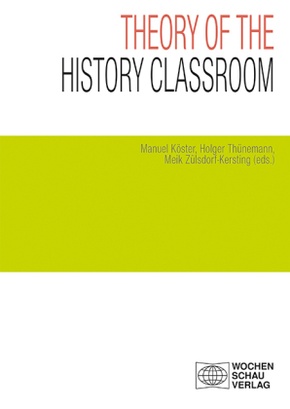| Verlag | Wochenschau-Verlag |
| Auflage | 2022 |
| Seiten | 240 |
| Format | 14,9 x 1,5 x 20,9 cm |
| Gewicht | 314 g |
| Artikeltyp | Englisches Buch |
| Reihe | Geschichtsunterricht erforschen |
| ISBN-10 | 3734413842 |
| EAN | 9783734413841 |
| Bestell-Nr | 73441384A |
This volume proposes a theory of history education in formal classroom settings. Specifically, it aims to outline how the particular setting of the classroom interacts with domain-specific processes of historical thinking. The theory rests on the notion that formal school education is a communicative and social system, while historical thinking occurs in the psychological system of a person's historical consciousness. In the complex interaction of these systems, historical thinking, emotions, communication, media and language are of particular importance. Drawing upon educational theory as well as the theory of history, this theory of the history classroom provides a framework as well as a solid foundation for future empirical research, both for developing research questions as well as for interpreting findings.
Inhaltsverzeichnis:
Manuel Köster, Holger Thünemann and Meik Zülsdorf-KerstingForeword to the English editionManuel Köster, Holger Thünemann1. Introduction to the German editionMeik Zülsdorf-Kersting2. The history classroom as a social system2.1 Introduction2.2 Theory of classroom education - remarks from a theory of science perspective2.3 Classroom education as a social system2.3.1 Models of classroom education2.3.2 Modelling utilisation of learning opportunities2.3.3 Systems theory and the history classroom2.3.4 Contingency and the history classroom2.3.5 Emergence and the history classroom2.3.6 Pedagogicity and communication2.3.7 The system and the environment of the history classroom2.3.8 Genesis of the form of the history classroom2.4 History didactics and theories of history in the classroom - an overview2.5 Between contingency and contingency constraints - a systems theory view of history in the classroom2.5.1 The concept of the history classroom2.5.2 Structural model of the history classroom2. 5.2.1 Historical thinking2.5.2.2 Emotions in the history classroom2.5.2.3 Communication in the history classroom2.5.2.4 Media in the history classroom2.5.2.5 Language in the history classroomHolger Thünemann and Johannes Jansen3. Learning to think historically3.1 Introduction3.2 Traditions in history didactics and models of historical thinking3.2.1 English-speaking countries - concepts of historical thinking3.2.2 German-speaking countries - historical consciousness in history didactics3.2.2.1 Historical consciousness and historical thinking I: Jeismann3.2.2.2 Historical consciousness and historical thinking II: Rüsen3.2.2.3 Historical consciousness and historical thinking III: Hasberg and Körber3.2.2.4 Historical consciousness and historical thinking IV: Competency models of historical thinking3.3 The HISTOGRAPH model of historical thinking - towards synthesis3.3.1 Historical queries3.3.2 Historical case analyses3.3.3 Historical causal judgements3.3.4 Historical value judgements3. 3.5 Historical thinking and historical knowledge3.3.6 Historical thinking, historical learning and acquiring historical competencySebastian Brack and Colin Flaving4. Emotions in the history classroom4.1 Introduction4.2 Emotions in history didactics4.3 Theory of emotions4.3.1 Genesis of emotions4.3.2 Components, functions and effects of emotions4.3.3 Controlling emotions4.4 Emotions and historical learning4.4.1 Emotions and learning4.4.2 Emotions and historical thinking4.5 Emotions in the social system of the history classroom4.6 The history classroom and theory of emotionsChristoph Wilfert and Simone Lankes5. Communication5.1 Introduction5.2 Historical thinking and communication5.3 Learning reflexive historical thinking by communicating5.4 The classroom as a communicative space5.4.1 Communication-based roles in the classroom5.4.2 Core structure of classroom communication: IRE sequences5.4.3 Organising turn-taking5.5 Negotiating history in classroom communicationJennifer Lahmer-Geb auer6. Media in the history classroom6.1 Introduction6.2 Sources and accounts as distribution media in the social system of the history classroom6.2.1 Importance of sources and accounts for learning history in the classroom6.2.2 Dealing with sources and accounts in the history classroom marked by subject-specific pedagogicity6.2.3 Consequences for communication in the social system of the history classroom6.3 A systems theory perspective on media in the history classroom6.3.1 Meaning: the universal medium6.3.2 Communication media6.3.2.1 Language6.3.2.2 Symbolically generalised communication media6.4 ConclusionManuel Köster and Christian Spieß7. Language7.1 Language in the social system of the history classroom7.2 Dimension 1: registers7.2.1 Casual register7.2.2 Academic and technical register7.2.3 Pedagogical register7.3 Dimension 2: languages of the history classroom7.3.1 The languages of history as a subject7.3.

